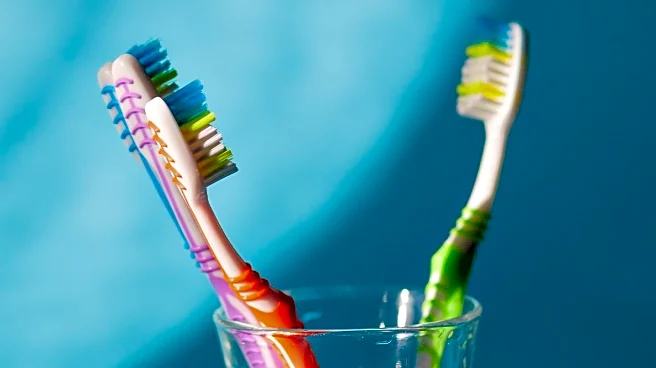What's Happening?
Recent research highlights that toothbrushes can harbor between 1 to 12 million bacteria and fungi, including viruses, which form biological films on the bristles. These microorganisms thrive due to the daily
influx of water, saliva, skin cells, and food traces from our mouths. While the risk from these pathogens is generally small, it poses a greater concern for individuals with compromised immune systems. Some bacteria found on toothbrushes carry antibiotic-resistant genes, making infections harder to treat. Despite the presence of antimicrobial treatments in some toothbrushes, studies suggest they do little to reduce bacterial numbers and may even increase antimicrobial-resistant species.
Why It's Important?
The presence of antibiotic-resistant bacteria on toothbrushes is a moderate public health concern, particularly for those with weakened immune systems. This issue underscores the importance of proper toothbrush hygiene to prevent potential infections. The findings also raise questions about the effectiveness of antimicrobial treatments in consumer products, suggesting a need for further research and possibly new guidelines for toothbrush care. The broader implications for public health include the potential spread of resistant bacteria, which could complicate treatment options and increase healthcare costs.
What's Next?
To mitigate the risks, experts recommend allowing toothbrushes to air dry at room temperature in an upright position, as many viruses and bacteria break down as they dry. This simple practice could significantly reduce the microbial load on toothbrushes. Further research may focus on developing more effective antimicrobial treatments or alternative materials for toothbrushes to minimize bacterial growth. Public health campaigns might also emphasize the importance of regular toothbrush replacement and proper storage to enhance oral hygiene and prevent infections.
Beyond the Headlines
The study of toothbrush microbiomes could lead to a better understanding of how everyday items contribute to the spread of antibiotic-resistant bacteria. This research may prompt a reevaluation of other common household items and their role in public health. Additionally, the findings could influence consumer behavior, encouraging more conscientious hygiene practices and potentially driving demand for innovative oral care products.











